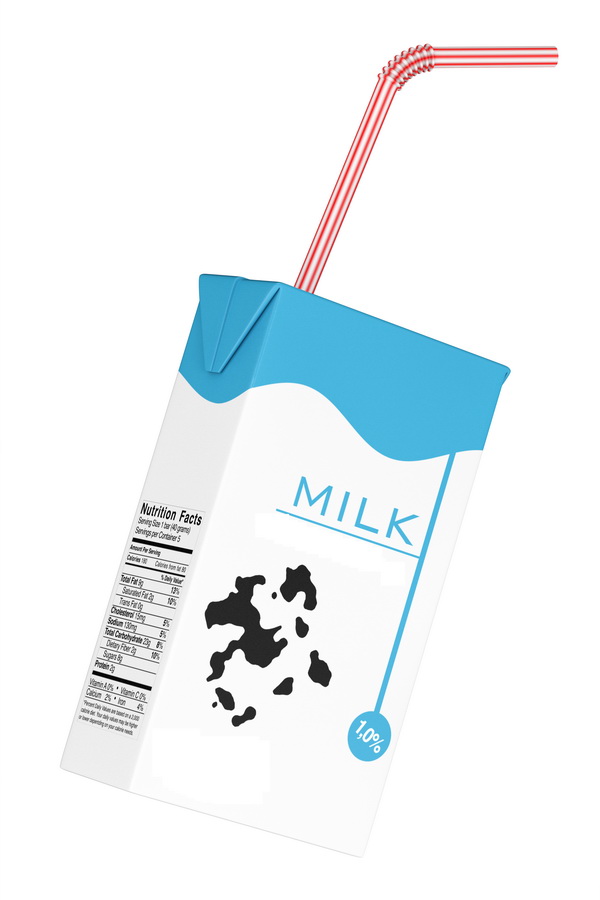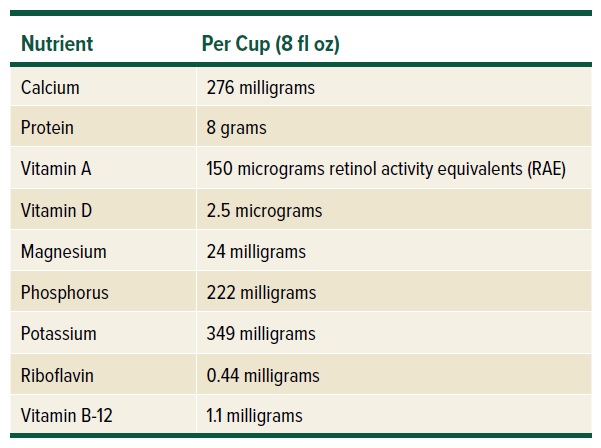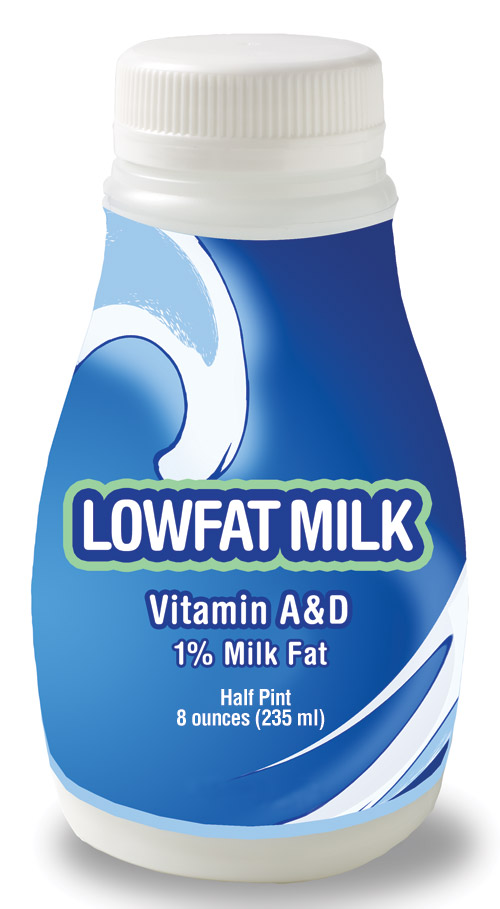
Regulations for Child Nutrition Programs (CNP) require that fluid milk be offered at each breakfast, lunch, or supper meal service. Fluid milk is optional at supper for adult participants of the Child and Adult Food Care Program (CACFP). Fluid milk may be served as a beverage, on cereal, or both at breakfast and snack; however, fluid milk must be served as a beverage in a lunch or a supper meal. Program operators have the option to serve fluid milk as one of the two required meal components of a snack served in the Summer Food Service Program (SFSP), CACFP, and the National School Lunch Program (NSLP) afterschool snack service (NSLP afterschool snacks). State agencies can set stricter requirements than the minimum nutrition standards for school meals. For additional guidance please contact your State agency.
Fluid milk refers to pasteurized, fat-free milk (skim), low-fat milk (1%), reduced-fat milk (2%), whole milk, lactose-free milk, lactose-reduced milk, cultured milk, such as cultured buttermilk, cultured kefir milk, and cultured acidophilus milk, acidified milk, such as acidified kefir milk and acidified acidophilus milk, and Ultra High Temperature (UHT) milk, all of which meet State and local standards for such milk. The fluid milk must also contain vitamins A and D at levels specified by the U.S. Food and Drug Administration. Please note that not all fluid milk on this list apply to all CNP, and some of the fluid milk may be flavored. Refer to the sections below for program-specific information related to the fluid milk requirement.
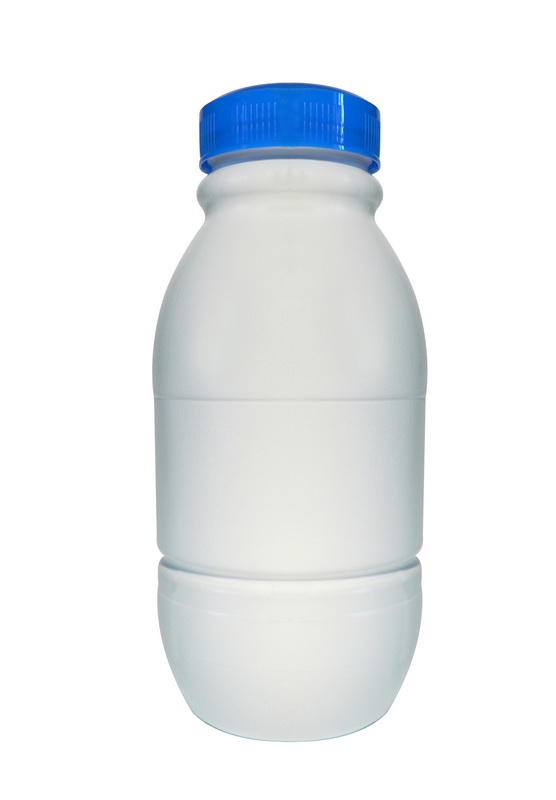
School food authorities (SFAs) must offer at least two different options of fluid milk at each meal service, one of which must be unflavored milk. SFAs may offer fat-free (skim) and low-fat milk (1%), flavored and unflavored, to K–12 students. By July 1, 2025, flavored milk must contain no more than 10 grams of added sugars per 8 fluid ounces or, for flavored milk sold as a competitive food for middle and high schools, no more than 15 grams of added sugars per 12 fluid ounces.
Fat-free or low-fat lactose-free and lactose-reduced milk may also be offered. Fat-free or low-fat cultured milk, such as cultured buttermilk, cultured kefir milk, and cultured acidophilus milk, and fat-free or low-fat acidified milk, such as acidified kefir milk and acidified acidophilus milk, and UHT milk are also allowed. Such products must be pasteurized fluid milk that meets State and local standards.
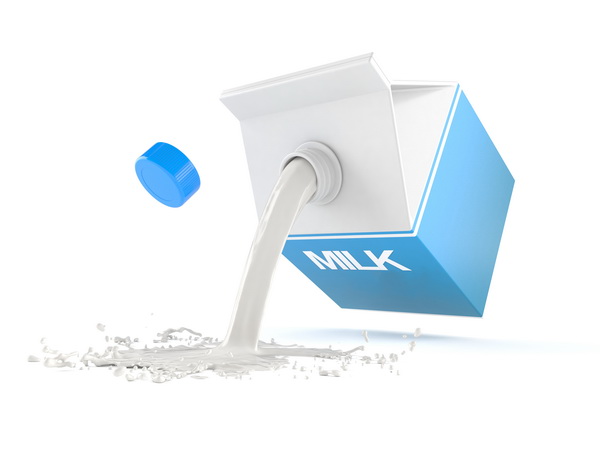
Fluid milk varieties allowed for the SFSP include unflavored or flavored: fat-free milk (skim), low-fat milk (1%), reduced-fat milk (2%), whole milk, lactose-free milk, lactose-reduced milk, cultured milk, such as cultured buttermilk, cultured kefir milk, and cultured acidophilus milk, and acidified milk, such as acidified kefir milk and acidified acidophilus milk, and UHT milk.
Children 1 Year Old
Children 1 year of age must be served unflavored whole milk.
Children 2 through 5 Years Old
Children 2 through 5 years old must be served unflavored fat-free (skim) or unflavored low-fat milk (1%).
Children 6 Years Old and Older
Children 6 years old and older must be served fat-free milk (skim) or low-fat milk. Milk may be flavored or unflavored.
Smoothies containing milk may be offered as part of reimbursable meals and snacks in CNP. Smoothies can be prepared in-house or commercially. Some ingredients in smoothies, including fluid milk, may credit as long as there is documentation showing how the product meets meal pattern requirements. Acceptable forms of documentation include Product Formulation Statements (PFS) or Child Nutrition (CN) labels for commercially prepared smoothies. Smoothies prepared in-house must be documented with a standardized recipe. The type of milk used in the smoothie must be consistent with the policies for the program, meal, and age group being served. Smoothies must contain at least ¼ cup (2 fluid ounces) of fluid milk per serving to credit toward the milk component. If the smoothie contains less than the minimum amount of fluid milk required, additional fluid milk must be offered.
Nondairy beverages offered as fluid milk substitutes may also be offered in the NSLP, SBP, SMP and CACFP. However, they must be nutritionally equivalent to milk and provide specific levels of calcium, protein, vitamins A and D, magnesium, phosphorus, potassium, riboflavin, and vitamin B-12. For more information about fluid milk substitutes for non-disability reasons please see program guidance.
The data on milk in the yield tables includes yield information on common types and customary serving sizes of products that you can buy on the market.
The columns are as follows:
Column 1: Food As Purchased (AP)
The individual foods are arranged in alphabetical order.
Column 2: Purchase Unit
The purchase unit is specified, for example, 1 cup, 1 half pint, 1 quart, 1 gallon. You can use data for one purchase unit to determine how much product you need for a specific number of servings.
Column 3: Servings per Purchase Unit, Edible Portion (EP)
This column shows the number of servings of a given size (found in "Serving Size per Meal Contribution" column) from each purchase unit (found in "Purchase Unit" colum). Numbers in this column are generally rounded down in order to help ensure enough food for the number of servings.
Column 4: Serving Size per Meal Contribution
The size of a serving is given as a volume. The serving size and contribution to the meal pattern are the same.
Column 5: Purchase Units for 100 Servings
This column shows the number of purchase units (found in "Purchase Unit" column) you need for 100 servings. Numbers in this column are generally rounded up in order to help ensure enough food is purchased for the required number of servings.
Column 6: Additional Information
This column gives other information to help you calculate the amount of food you need toprepare meals. Column 6 information is not available for milk.








